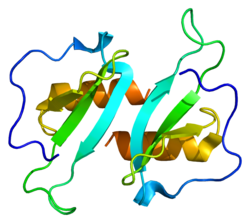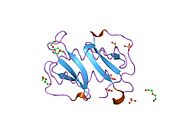CCL20
Chemokine (C-C motif) ligand 20(CCL20) orliver activation regulated chemokine(LARC) orMacrophage Inflammatory Protein-3(MIP3A) is a smallcytokinebelonging to the CCchemokinefamily. It is stronglychemotacticforlymphocytesand weakly attractsneutrophils.[5]CCL20 is implicated in the formation and function ofmucosallymphoid tissuesvia chemoattraction oflymphocytesanddendritic cellstowards theepithelial cellssurrounding these tissues. CCL20 elicits its effects on its target cells by binding and activating thechemokine receptorCCR6.[6]
Geneexpression of CCL20 can be induced bymicrobialfactors such aslipopolysaccharide(LPS), and inflammatory cytokines such astumor necrosis factorandinterferon-γ,and down-regulated byIL-10.[7]CCL20 is expressed in several tissues with highest expression observed in peripheral bloodlymphocytes,lymph nodes,liver,appendix,andfetallungand lower levels in thymus, testis, prostate and gut.[5][8]The gene for CCL20 (scya20) is located on chromosome 2 in humans.[9]
Recent research[10]in an animal model of multiple sclerosis known as experimental autoimmune encephalitis (EAE) demonstrated that regional neural activation can create "gates" for pathogenicCD4+ T cells to enter the CNS by increasing CCL20 expression, especially at L5. Sensory nerve stimulation, elicited by using muscles in the leg or electrical stimulation as in Arima et al., 2012, activates sympathetic neurons whose axons run through the dorsal root ganglia containing cell bodies of the stimulated afferent sensory nerve. Sympathetic neuronal activity activates IL-6 amplifier resulting in increased regional CCL20 expression and subsequent pathogenic CD4+ T cell accumulation at the same spinal cord level. CCL20 expression was observed to be dependent on IL-6 amplifier activation, which is dependent onNF-κBandSTAT3activation. This research provides evidence for a critical role for CCL20 in autoimmune pathogenesis of the central nervous system.
References[edit]
- ^abcGRCh38: Ensembl release 89: ENSG00000115009–Ensembl,May 2017
- ^abcGRCm38: Ensembl release 89: ENSMUSG00000026166–Ensembl,May 2017
- ^"Human PubMed Reference:".National Center for Biotechnology Information, U.S. National Library of Medicine.
- ^"Mouse PubMed Reference:".National Center for Biotechnology Information, U.S. National Library of Medicine.
- ^abHieshima K, Imai T, Opdenakker G, Van Damme J, Kusuda J, Tei H, Sakaki Y, Takatsuki K, Miura R, Yoshie O, Nomiyama H (1997)."Molecular cloning of a novel human CC chemokine liver and activation-regulated chemokine (LARC) expressed in liver. Chemotactic activity for lymphocytes and gene localization on chromosome 2".J. Biol. Chem.272(9): 5846–5853.doi:10.1074/jbc.272.9.5846.PMID9038201.
- ^Baba M, Imai T, Nishimura M, Kakizaki M, Takagi S, Hieshima K, Nomiyama H, Yoshie O (1997)."Identification of CCR6, the specific receptor for a novel lymphocyte-directed CC chemokine LARC".J. Biol. Chem.272(23): 14893–14898.doi:10.1074/jbc.272.23.14893.PMID9169459.
- ^Schutyser E, Struyf S, Menten P, Lenaerts JP, Conings R, Put W, Wuyts A, Proost P, Van Damme J (2000)."Regulated production and molecular diversity of human liver and activation-regulated chemokine/macrophage inflammatory protein-3 alpha from normal and transformed cells".J. Immunol.165(8): 4470–7.doi:10.4049/jimmunol.165.8.4470.PMID11035086.
- ^Rossi DL, Vicari AP, Franz-Bacon K, McClanahan TK, Zlotnik A (1997)."Identification through bioinformatics of two new macrophage proinflammatory human chemokines: MIP-3alpha and MIP-3beta".J. Immunol.158(3): 1033–6.doi:10.4049/jimmunol.158.3.1033.PMID9013939.S2CID39291729.
- ^Nelson RT, Boyd J, Gladue RP, Paradis T, Thomas R, Cunningham AC, Lira P, Brissette WH, Hayes L, Hames LM, Neote KS, McColl SR (2001). "Genomic organization of the CC chemokine mip-3alpha/CCL20/larc/exodus/SCYA20, showing gene structure, splice variants, and chromosome localization".Genomics.73(1): 28–37.doi:10.1006/geno.2001.6482.PMID11352563.
- ^Regional Neural Activation Defines a Gateway for Autoreactive T Cells to Cross the Blood-Brain Barrier | author = Arima, Yasunobu; Harada, Masaya; Kamimura, Daisuke; Park, Jin-Haeng; Kawano, Fuminori; Yull, Fiona E.; Kawamoto, Tadafumi; Iwakura, Yoichiro; Betz, Ulrich A.K.; Marquez, Gabriel; Blackwell, Timothy S.; Ohira, Yoshinobu; Hirano, Toshio; Murakami, Masaaki | Cell doi:10.1016/j.cell.2012.01.022 (volume 148 issue 3 pp.447 - 457)
Further reading[edit]
- Matoba R, Okubo K, Hori N, et al. (1994). "The addition of 5'-coding information to a 3'-directed cDNA library improves analysis of gene expression".Gene.146(2): 199–207.doi:10.1016/0378-1119(94)90293-3.PMID8076819.
- Rossi DL, Vicari AP, Franz-Bacon K, et al. (1997)."Identification through bioinformatics of two new macrophage proinflammatory human chemokines: MIP-3alpha and MIP-3beta".J. Immunol.158(3): 1033–6.doi:10.4049/jimmunol.158.3.1033.PMID9013939.S2CID39291729.
- Hieshima K, Imai T, Opdenakker G, et al. (1997)."Molecular cloning of a novel human CC chemokine liver and activation-regulated chemokine (LARC) expressed in liver. Chemotactic activity for lymphocytes and gene localization on chromosome 2".J. Biol. Chem.272(9): 5846–5853.doi:10.1074/jbc.272.9.5846.PMID9038201.
- Hromas R, Gray PW, Chantry D, et al. (1997). "Cloning and characterization of exodus, a novel beta-chemokine".Blood.89(9): 3315–22.PMID9129037.
- Baba M, Imai T, Nishimura M, et al. (1997)."Identification of CCR6, the specific receptor for a novel lymphocyte-directed CC chemokine LARC".J. Biol. Chem.272(23): 14893–14898.doi:10.1074/jbc.272.23.14893.PMID9169459.
- Liao F, Alderson R, Su J, et al. (1997)."STRL22 is a receptor for the CC chemokine MIP-3alpha".Biochem. Biophys. Res. Commun.236(1): 212–217.doi:10.1006/bbrc.1997.6936.PMID9223454.
- Power CA, Church DJ, Meyer A, et al. (1997)."Cloning and characterization of a specific receptor for the novel CC chemokine MIP-3alpha from lung dendritic cells".J. Exp. Med.186(6): 825–835.doi:10.1084/jem.186.6.825.PMC2199050.PMID9294137.
- Tanaka Y, Imai T, Baba M, et al. (1999)."Selective expression of liver and activation-regulated chemokine (LARC) in intestinal epithelium in mice and humans".Eur. J. Immunol.29(2): 633–642.doi:10.1002/(SICI)1521-4141(199902)29:02<633::AID-IMMU633>3.0.CO;2-I.PMID10064080.
- Yang D, Howard OM, Chen Q, Oppenheim JJ (1999)."Cutting edge: immature dendritic cells generated from monocytes in the presence of TGF-beta 1 express functional C-C chemokine receptor 6".J. Immunol.163(4): 1737–41.doi:10.4049/jimmunol.163.4.1737.PMID10438902.S2CID14563599.
- Yang D, Chertov O, Bykovskaia SN, et al. (1999). "Beta-defensins: linking innate and adaptive immunity through dendritic and T cell CCR6".Science.286(5439): 525–528.doi:10.1126/science.286.5439.525.PMID10521347.
- Charbonnier AS, Kohrgruber N, Kriehuber E, et al. (2000)."Macrophage inflammatory protein 3alpha is involved in the constitutive trafficking of epidermal langerhans cells".J. Exp. Med.190(12): 1755–1768.doi:10.1084/jem.190.12.1755.PMC2195721.PMID10601351.
- Schutyser E, Struyf S, Menten P, et al. (2000)."Regulated production and molecular diversity of human liver and activation-regulated chemokine/macrophage inflammatory protein-3 alpha from normal and transformed cells".J. Immunol.165(8): 4470–7.doi:10.4049/jimmunol.165.8.4470.PMID11035086.
- Hirose J, Kawashima H, Yoshie O, et al. (2001)."Versican interacts with chemokines and modulates cellular responses".J. Biol. Chem.276(7): 5228–5234.doi:10.1074/jbc.M007542200.PMID11083865.
- Nakayama T, Fujisawa R, Yamada H, et al. (2001)."Inducible expression of a CC chemokine liver- and activation-regulated chemokine (LARC)/macrophage inflammatory protein (MIP)-3 alpha/CCL20 by epidermal keratinocytes and its role in atopic dermatitis".Int. Immunol.13(1): 95–103.doi:10.1093/intimm/13.1.95.PMID11133838.
- Nelson RT, Boyd J, Gladue RP, et al. (2001). "Genomic organization of the CC chemokine mip-3alpha/CCL20/larc/exodus/SCYA20, showing gene structure, splice variants, and chromosome localization".Genomics.73(1): 28–37.doi:10.1006/geno.2001.6482.PMID11352563.
- Tohyama M, Shirakara Y, Yamasaki K, et al. (2001). "Differentiated keratinocytes are responsible for TNF-alpha regulated production of macrophage inflammatory protein 3alpha/CCL20, a potent chemokine for Langerhans cells".J. Dermatol. Sci.27(2): 130–139.doi:10.1016/S0923-1811(01)00127-X.PMID11532377.
- Giannini SL, Hubert P, Doyen J, et al. (2002). "Influence of the mucosal epithelium microenvironment on Langerhans cells: implications for the development of squamous intraepithelial lesions of the cervix".Int. J. Cancer.97(5): 654–659.doi:10.1002/ijc.10084.PMID11807793.S2CID24940837.
- Casamayor-Pallejà M, Mondière P, Verschelde C, et al. (2002)."BCR ligation reprograms B cells for migration to the T zone and B-cell follicle sequentially".Blood.99(6): 1913–1921.doi:10.1182/blood.V99.6.1913.PMID11877260.
- Schmuth M, Neyer S, Rainer C, et al. (2002). "Expression of the C-C chemokine MIP-3 alpha/CCL20 in human epidermis with impaired permeability barrier function".Exp. Dermatol.11(2): 135–142.doi:10.1034/j.1600-0625.2002.110205.x.PMID11994140.S2CID40953753.
- Liao F, Shirakawa AK, Foley JF, et al. (2002)."Human B cells become highly responsive to macrophage-inflammatory protein-3 alpha/CC chemokine ligand-20 after cellular activation without changes in CCR6 expression or ligand binding".J. Immunol.168(10): 4871–80.doi:10.4049/jimmunol.168.10.4871.PMID11994436.
External links[edit]
- HumanCCL20genome location andCCL20gene details page in theUCSC Genome Browser.








